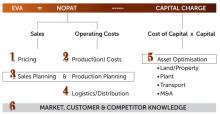For such an operationally-focused industry, the aggregates sector is very poor at planning … especially sales and operational planning (S&OP). This isn’t really that much of a surprise, because most aggregates managers would rather be out and about in the quarry or the marketplace making and selling their products, rather than sitting in the office making plans. However, S&OP is a key part of any company’s success. Join our experts from Commercial Performance to find out why planning is so important. What are the most common issues and problems?
If you don’t know where you’re going, how will you know when you get there? The truth is you won’t … which is why planning is essential if you and your business want to succeed. We plan to fail when we fail to plan. Sales and operational planning (S&OP) is the best way forward. It is, says Commercial Performance, “essentially about matching supply with demand to reduce uncertainty.”
The “sales part is about understanding demand or more simply sales forecasting. This is where S&OP starts. The operational part is about inventory and supply chain management … looking at things like product flow, primary and secondary stock levels and pit balancing decisions.”
This is the third feature in our series of Six Deadly Sins and, says Commercial Performance, “the principles involved are no different to those in our previous two features on product costing and pricing … the single most important thing we can advise you to do is to sit down and take time out to consider the pitfalls of not doing S&OP well.”
When you do this, say consultancy experts at Commercial Performance, you will quickly “realise the serious impact it can have on your business, namely, the destruction of value and the creation of unhappy investors due to high stock levels, increased by-product waste, missed higher pricing and lost market opportunities … to name a few.”
And, “what is surprising, is that doing S&OP well only requires discipline around a few key factors to avoid such pitfalls. Let us help you to create happy investors and generate wealth. So, let’s take a look at these … starting with sales forecasting and its essentials:”
1. Know your customer and your market. Any forecast requires pertinent knowledge and a sales forecast requires good knowledge of demand from each customer in the market. It sounds easy, but how many sales teams have really ‘good’ knowledge of their customers and their customer’s customer? How many capture the information on even the most basic CRM (client record management) system? This is often the place where the sales forecasting process begins to fail … the point at which teams often fail to have a good grasp of buying behaviour. The basic minimum you should know is volumes and prices by product type and by quarry … but you will also need a good grasp of things like how your customers tend to negotiate and demand discounts by product or by project. This is especially critical in the case of large/multiple tenders or where the customer’s customer can change or influence specifications. Understanding this ‘supply chain’ is invaluable, particularly in highly fragmented and dynamic markets. Great aggregates teams use technology to capture sales data. They find out all about other buyers’ intentions and they know where the trigger points are in the decision-making chain. And they do this consistently. Just like a supermarket, successful aggregates teams know what their clients generally buy and they know exactly how the market responds to certain incentives. Do you?







